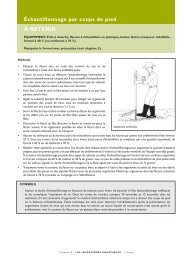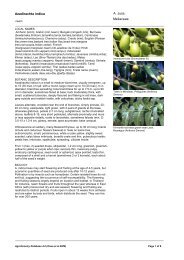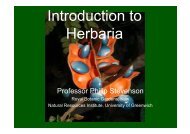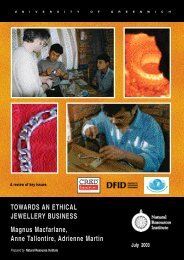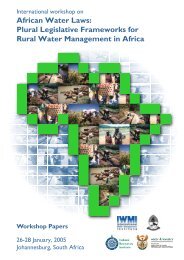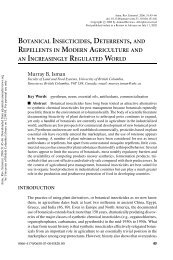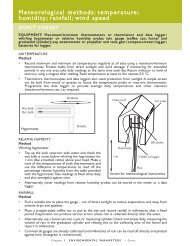Farmers' ethno-ecological knowledge of vegetable pests and ...
Farmers' ethno-ecological knowledge of vegetable pests and ...
Farmers' ethno-ecological knowledge of vegetable pests and ...
You also want an ePaper? Increase the reach of your titles
YUMPU automatically turns print PDFs into web optimized ePapers that Google loves.
Figure 3 Major <strong>pests</strong> <strong>of</strong> Brassica <strong>and</strong> tomato mentioned by respondents in northern Malawi (a & c) <strong>and</strong> eastern Zambia (b<br />
& d). Values were calculated as the percentages <strong>of</strong> all insect pest species mentioned by the respondents<br />
reported using pesticides that are hazardous (class I)<br />
according to the WHO classification as well as products<br />
not recommended for control <strong>of</strong> pest in <strong>vegetable</strong> crops<br />
(Table 4 <strong>and</strong> 5). In some instances, farmers only knew<br />
pesticides by their trade names, which vary widely. This<br />
was frequent in Eastern Zambia where the same product<br />
was known by different names.<br />
The use <strong>of</strong> pesticidal plants, cultural practices <strong>and</strong><br />
resistant varieties constituted a smaller portion <strong>of</strong> the pest<br />
control options in both crucifers <strong>and</strong> tomato. Cultural<br />
practices mainly involved h<strong>and</strong>-picking <strong>and</strong> destroying<br />
visible insects. Respondents reported over 20 different<br />
pesticidal plant species (Table 6). These included<br />
Tephrosia vogelii, neem (Azadirachta indica), Mucuna<br />
pruriens, Bobgunnia (Swartzia) madagascarensis,<br />
Euphorbia tirucali, Vernonia amygdalina, Tithonia<br />
diversifolia, Solanum p<strong>and</strong>uriforme <strong>and</strong> tobacco<br />
(Nicotiana tabacum) (Table 6). Respondents in the study<br />
areas sometimes identified the same species with<br />
different local names. The values presented in Table 6<br />
were calculated as the percentages <strong>of</strong> all species<br />
mentioned by the respondents. This was done to enable<br />
listing <strong>of</strong> priority species for further studies. Accordingly,<br />
T. vogelii accounted for 67% <strong>and</strong> 63% <strong>of</strong> the species<br />
known to the respondents as pesticidal plants in Northern<br />
Malawi <strong>and</strong> Eastern Zambia, respectively (Table 4).<br />
However, only 13.2% <strong>of</strong> the respondents had actually<br />
used T. vogelii for pest control despite most being aware<br />
<strong>of</strong> it. T. diversifolia, V. amygdalina, E. tirucali <strong>and</strong> A.<br />
indica were the other most frequently reported pesticidal<br />
plant species but there may be numerous others yet to be<br />
identified.<br />
Awareness <strong>of</strong> pesticidal plants was associated<br />
significantly only with the educational level <strong>of</strong><br />
respondents. The significant determinants <strong>of</strong> use <strong>of</strong><br />
pesticidal plants were gender (χ 2 = 6.0, P = 0.014),<br />
education (χ 2 = 10.3, P = 0.006) <strong>and</strong> l<strong>and</strong> holding size (χ 2<br />
= 15.9, P = 0.004) (Table 7). More female respondents<br />
(75%) were reported using pesticidal plants than their<br />
male counterparts (55%). The majority <strong>of</strong> respondents<br />
(73%) who attended secondary school had used<br />
pesticidal plants while 93% <strong>of</strong> those who did not go to



